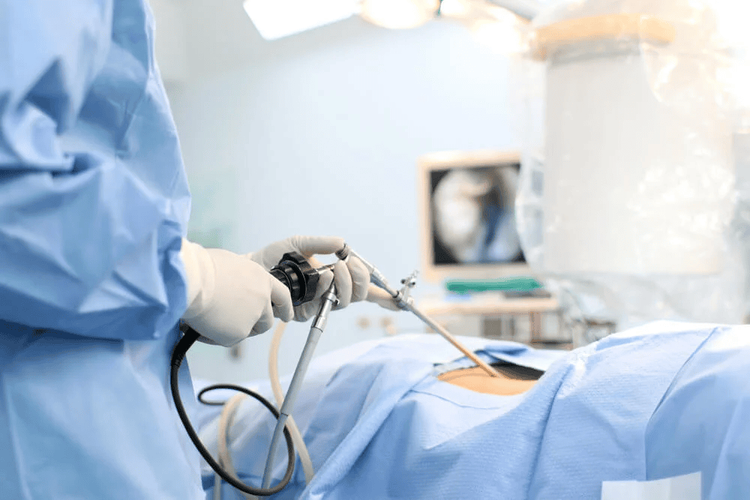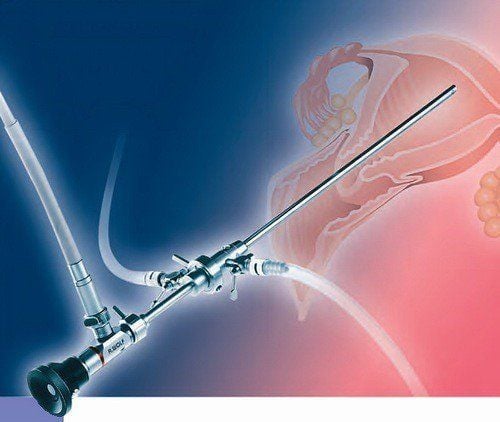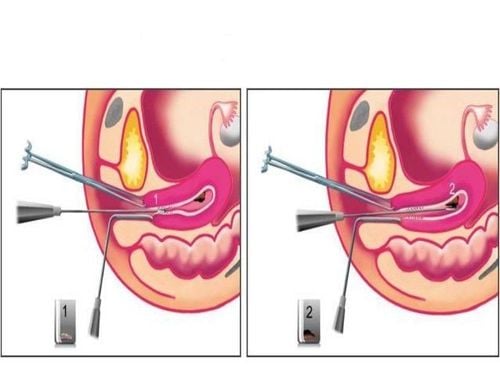This is an automatically translated article.
The article was professionally consulted by Doctor Nguyen Chi Quang, Department of Obstetrics and Gynecology - Department of Obstetrics and Gynecology - Vinmec Central Park International General Hospital.Hysteroscopy is a technique that allows the doctor to look inside the uterus to diagnose and treat the causes of abnormal uterine bleeding. Today, this is also a popular means to approach many other gynecological diseases, with high efficiency.
1. What is hysteroscopy?
The uterus is an important female reproductive organ, the site of embryo implantation and the attachment of the placenta that nourishes the fetus during pregnancy. If there is no pregnancy, the endometrium will proliferate and shed according to the rules, forming the menstrual cycle.Hysteroscopy is a minimally invasive imaging tool that examines the inner surface of the uterus and identifies the cause of abnormal vaginal bleeding for many women.
To do this, the doctor uses a metal laparoscope to pass through the vagina, cervix and into the uterus. On the tube, there is a light source and camera attached, which helps to receive and transmit images out, displayed on the screen so that many doctors can observe and find abnormalities in the uterine cavity. Not only that, the treatment can also be done at the same time thanks to the introduction of interventional instruments, helping the diagnosis and treatment of diseases by means of hysteroscopy only take place in the same procedure. submit.
Hysteroscopy usually takes 30 to 45 minutes and is performed as an outpatient technique, meaning that the patient does not need to stay in the hospital but goes home the same day. This technique is less painful, so the patient only needs local or spinal anesthesia. Therefore, patients should be scheduled in advance and should not eat or drink for at least 4 to 8 hours before the procedure.
2. The role of hysteroscopy in the treatment of uterine bleeding
Today, as hysteroscopy is becoming more and more popular, the causes of suspected vaginal bleeding from the uterus are more clearly identified and treated effectively.Accordingly, hysteroscopy is indicated for the following purposes:
Locate and evaluate the cause of uterine bleeding, such as submucosal fibroids or variable polyps. severe anemia; Diagnosis and treatment of endometrial hyperplasia

However, in order for hysteroscopy in particular and endoscopic techniques of internal organs in general to be carried out safely and effectively in disease detection and treatment, the professional qualifications and experience of the on-call doctor are required. implementation as well as the system of facilities and equipment plays an extremely important role.
In addition, because hysteroscopy only helps to examine intrauterine lesions, the limitation of this technique is that it is not suitable for examining or diagnosing pathologies occurring in the muscular wall or inside the uterus. ectopic. Also, although the laparoscope can show images up to the opening of the fallopian tubes to the uterine cavity, it does not directly examine the fallopian tubes.
3. How to conduct hysteroscopy
3.1. Preparation Hysteroscopy is performed only after the cause of uterine bleeding cannot be determined by other means. Accordingly, in order to limit the risks that this technique can bring, the endoscopy needs to be properly indicated and not violate contraindications.Contraindications of hysteroscopy are women who are pregnant or have appendicitis, uterine or cervical cancer. In addition, occlusion of the cervical opening may make laparoscopy difficult or impossible.
Before performing hysteroscopy, the patient is examined by gynecology as well as other organ systems to ensure that the patient can physically tolerate the procedure. Then, when scheduled, the patient is instructed to fast and clean the body in accordance with regulations.
Depending on the goals and health status of each patient, hysteroscopy can be performed on an outpatient basis or need to be inpatient. Laparoscopy can sometimes be performed in the operating room if a combination of surgical intervention is anticipated. Therefore, the doctor will advise patients and relatives in detail on how to prepare as well as anesthetic or anesthetic methods before performing endoscopy.
3.2. Procedure Depending on the suspected pathology, age and number of children born to the patient, the doctor will choose the appropriate size of the laparoscope inserted into the uterine cavity through the cervical opening. This also depends on the purpose of the endoscopy as well as the intention of the interventional techniques to be performed at the same time. In most cases, narrow-diameter endoscopes are used and the patient only needs local anesthesia without anesthesia.
In addition, to facilitate access, the patient will be placed a vaginal opening device, called a speculum, and after the laparoscope is inserted, the uterine cavity will be pumped with a small amount. Liquid or gas helps to stretch the uterine cavity, allowing clear and convenient collection of images. Besides, if the cervix is too firm and closed, making it difficult to insert the instrument, the doctor will prescribe drugs to help promote cervical dilation.

4. How is the follow-up after hysteroscopy?
If hysteroscopy is done on an outpatient basis, the patient can go home immediately after the procedure is over. In the event that general anesthesia is required, the patient should stay under observation until the effect of the drug wears off and must be brought home by a loved one, absolutely do not drive, operate machinery, or climb to heights. within 24 hours thereafter.After hysteroscopy, most patients experience vaginal bleeding but in very little amount and can return to normal activities almost immediately. Others still feel pain, need to take more common pain relievers such as paracetamol or ibuprofen.
However, if a woman experiences any of the following, she should return to the doctor soon:
Heavy and prolonged vaginal bleeding; Severe abdominal pain; Signs of infection, such as fever, chills, and purulent, thick, strong-smelling vaginal discharge.
5. Possible complications during hysteroscopy
In general, hysteroscopy is a very safe technique. However, like other techniques, hysteroscopy cannot completely avoid risks.In which, the heaviest complication is uterine or cervical perforation caused by the laparoscope, causing abdominal pain and bleeding into the abdomen. These cases require emergency surgical intervention to stop bleeding. In addition, hysteroscopy also has other complications such as a lot of blood loss due to trauma during intervention or infection... However, it is very rare that hysteroscopy can cause other complications. life-threatening problem.
In the era of development of medical techniques, hysteroscopy is becoming more and more popular. This is a useful method to help diagnose and intervene in some pathologies that cause abnormal uterine bleeding. When there are signs of non-cyclical vaginal bleeding, a woman needs to go to a trusted specialist hospital and have a laparoscopy performed as indicated, helping to detect the disease early and treat it promptly.
Before becoming a Doctor of Obstetrics and Gynecology at Vinmec Central Park International General Hospital, Dr. Nguyen Chi Quang used to work at Tu Du Hospital and University Hospital of Medicine and Pharmacy in Ho Chi Minh City. Dr. Quang has many years of deep professional experience and strength in the treatment of obstetric and gynecological diseases such as:
Laparoscopic surgery Uterine fibroids Laparoscopic surgery for ovarian tumors Laparoscopic surgery for genital prolapse
Please dial HOTLINE for more information or register for an appointment HERE. Download MyVinmec app to make appointments faster and to manage your bookings easily.
References: acog.org; emedicinehealth.com














